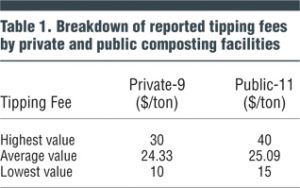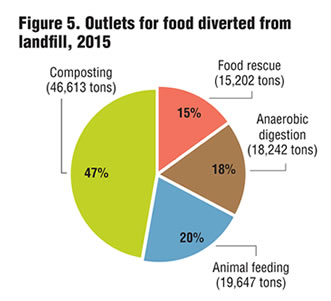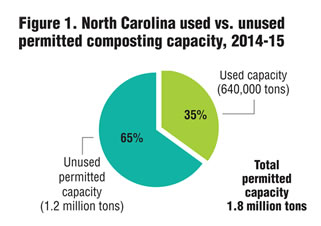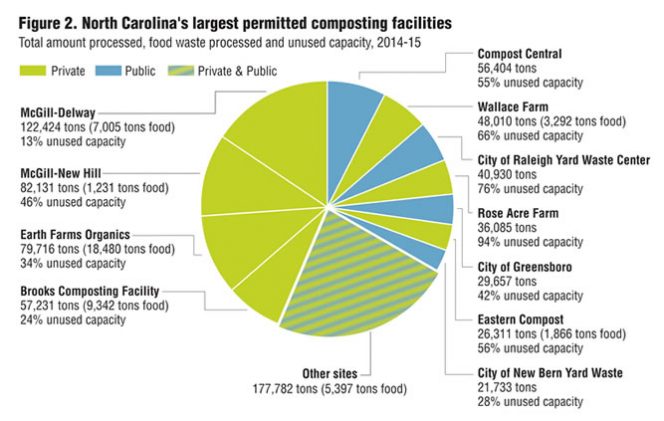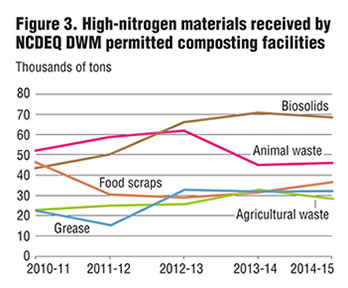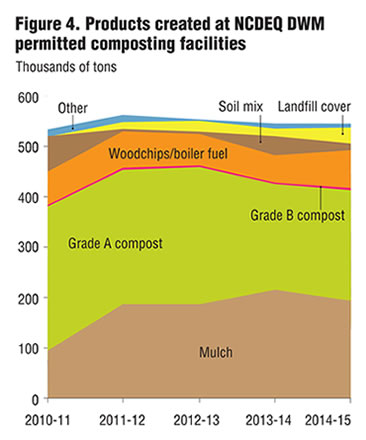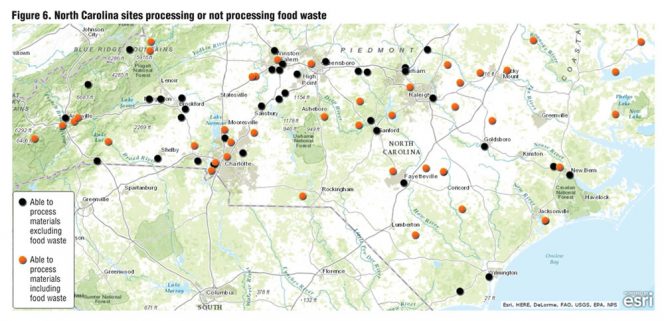A recent study by state agency analyzed organic materials recycled since 2011, as well as food waste recovered in 2015. Findings show substantial organics recycling capacity.
Jorge Montezuma
BioCycle September 2016
The North Carolina Department of Environmental Quality (NC DEQ) released a study in June 2016 analyzing the organic materials recycled since 2011, as well as food waste recovered in 2015. The facility reporting requirement in the North Carolina compost rules and the relationships built over the years with different players in the industry were essential to obtaining the necessary data for both parts of the study, and it shows healthy signs of organics recovery.
North Carolina has a robust network to recover wholesome food through hunger relief organizations and also to reuse excess food by processing it to feed animals, the soil, and the electricity grid. Though the state does not have a food waste disposal ban, it does have a yard trimmings ban in place that has been crucial to expand composting infrastructure. Continued progress in all of these areas has been supported by assistance from state and local governments and by effective action from the private and nonprofit sectors.
Feedstocks, Composting Facilities
The NCDEQ permits a range of organics recycling facilities, however this study focused on a subset of facilities permitted under the same regulatory group (Division of Waste Management’s (DWM) Solid Waste Section). In the latest reporting cycle (fiscal 2014-2015), the facilities consisted of 24 private, 23 public, and 5 college/university operations, which in total, received approximately 640,000 tons of organic material. Yard trimmings accounted for 51 percent of organics processed; food scraps accounted for 7 percent.
Figure 1 shows that North Carolina is using 35 percent (640,276 tons) of its available permitted capacity to process organic material and has available permitted capacity to process an additional 1.2 million tons. This is an approximation based on the available data from the NCDEQ DWM permitted composting facilities. Most recently, NCDEQ DWM has decided to no longer issue facility throughput limits on composting permits; it will only adhere to windrow and curing pile sizes and other dimensional design features to be followed as specified on the permit application. Due to this change, the language of available permitted capacity will shift to unused capacity for the purposes of this study, given that most composting facilities in the past have built their maximum footprints after they have been granted their permits.
Composting facilities across the state typically charge tipping fees for incoming materials. Table 1 summarizes fiscal 2014-15 tipping fees by 9 privately and 11 publicly operated facilities (an average of $26/ton). These values provide a total average and do not reflect the variety of tipping fees throughout the state nor differences in tipping fees based on the type of feedstock.
For comparison purposes, the average North Carolina landfill tipping fees in the same fiscal year were $38/ton at construction and demolition landfills (53 reporting sites) and $41/ton at municipal solid waste landfills (39 reporting sites). Even though the average composting tipping fee is below these two values, collection and transportation costs to composting facilities need to be factored in to account for potentially higher costs due to longer distances to reach the composting sites.
Figure 3 highlights trends for other materials processed at composting facilities that would be considered high in nitrogen content, such as sludge or biosolids, animal waste, food scraps, grease trap waste and agricultural waste. It shows upwards trends for sludge/biosolids (57% increase since 2010, or 11%/year), grease trap waste (43% increase since 2010, or 9%/year), and agricultural waste (23% increase since 2010, or 4.6%/year). Figure 3 also indicates downwards trends for animal waste (12% decrease since 2010, or 2.4%/year) and upwards trends for food waste in the past 3 years (26% increase since fiscal 2012-13, or 8.7%/year).
It was also found that from a subset of 6 private facilities, 3.7 jobs are generated per 10,000 tons of organic material composted, which is close to the average the Institute for Local Self-Reliance reported in 2013 of 4 jobs per 10,000 tons.
Compost, Mulch Markets
Figure 4 shows the tonnage distribution of the different products created at the state Division of Waste Management’s permitted composting facilities. These products are Grade A and Grade B compost, mulch, wood chips, engineered soils and client-specific soil mixtures, alternative daily (landfill) cover, and others. Grade A compost and mulch make up the majority of the materials manufactured; approximately 219,000 tons of Grade A compost and 194,000 tons of mulch were produced, with sales to the public accounting for approximately 58 percent of all material processed.
Grade A compost must contain <6 percent manmade inerts per sample (inerts must be <1 inch in size); Undergo a temperature-controlled composting method to meet “PFRP” (Process to Further Reduce Pathogens); and Meet metal concentrations as established by the rules. Grade B compost can have >6 percent manmade inerts per sample, does not need to meet PFRP, but must meet the metal concentrations.
Food Recovery
A 2012 NCDEQ study found North Carolina generates 1.2 million tons/year of food waste (not taking into account agricultural losses). In 2015, North Carolina diverted 99,704 tons, or 8.3 percent of excess food destined to the landfill. Figure 5 summarizes the food diverted from landfilling.
North Carolina is fortunate to have a well-established food rescue network, comprised of 7 major food banks and hundreds of distributing partners working through the North Carolina Association of Feeding America, as well as 9 college programs that are all part of the Food Recovery Network. Over 15,000 tons of wholesome and perishable food was donated and fed to people through these outlets in 2015.
The rest of the food (about 85,000 tons) was diverted through composting, animal feeding and anaerobic digestion operations via a network of 8 main hauling companies, including some that operate their own composting facilities. The state has 15 permitted composting facilities that accepted food scraps in 2015 — 8 received more than 100 tons/year each (composting 99% of the food sent to composting facilities), while 7 facilities accepted less than 100 tons each. As the map in Figure 6 indicates, there are more facilities with permit classifications that include food waste (i.e., Types 2, 3 or 4), but may not have been actually receiving food waste when the 2015 data was collected. To effectively move food waste to composting facilities, anaerobic digestion facilities, or animal feeding operations, a more robust network of collection services are needed that can service clusters of excess food generators.
One major outcome of this part of the study was the realization that to meet the U.S. Environmental Protection Agency/U.S. Department of Agriculture food waste reduction goal (50% reduction by 2030), North Carolina food recovery would have to increase 5.5 times, assuming current management practices continue. The sidebar briefly describes the infrastructure required to meet the EPA/USDA goal.
Establishing A Baseline
The NC Organics Recycling Study is the first of its kind in the state and provides a starting point to further analyze the flow of organic waste streams and their respective fates. Though some of the findings are very positive, it should be noted that many urban areas are well served when it comes to yard trimmings, biosolids, and grease trap processing, but still lack food waste collection and composting services.
In general, the lack of collection services is a huge barrier to achieving higher levels of donation of wholesome food and pre and postconsumer food waste composting. Public/private partnerships supported by state and local governments should continue to increase the diversion of organic materials, especially excess food, from landfills to create jobs, improve soil health, and reduce hunger. For its part, NCDEQ will continue to support food waste diversion through targeted grants and technical assistance, working to expand necessary services and infrastructure.
Jorge Montezuma, EIT, is the Organics Recycling Specialist for NC Department of Environmental Quality. The team at the non-regulatory state recycling program offers complimentary technical assistance and infrastructure grant funding.
